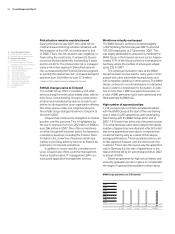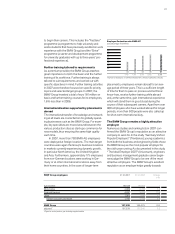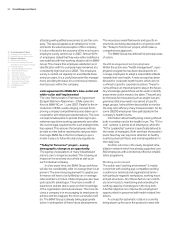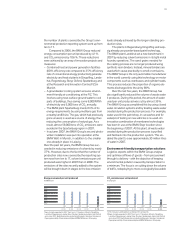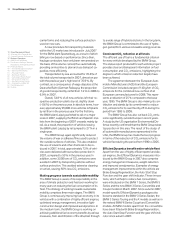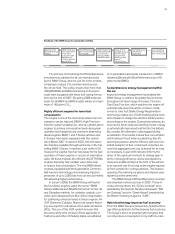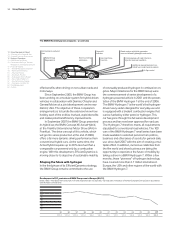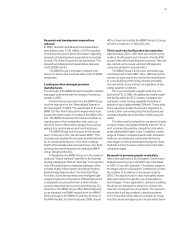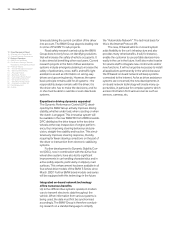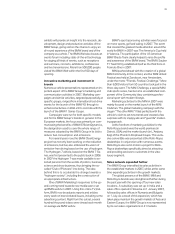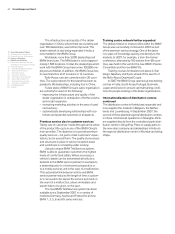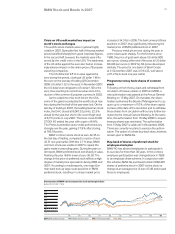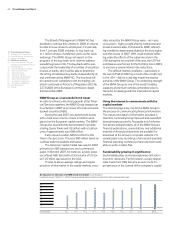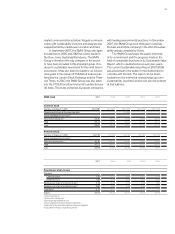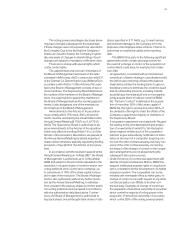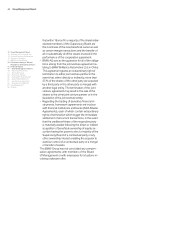BMW 2007 Annual Report Download - page 38
Download and view the complete annual report
Please find page 38 of the 2007 BMW annual report below. You can navigate through the pages in the report by either clicking on the pages listed below, or by using the keyword search tool below to find specific information within the annual report.36 Group Management Report
10 Group Management Report
10 A Review of the Financial Year
13 General Economic Environment
17 Review of Operations
41 BMW Stock and Bonds
44 Disclosures relating to Takeover
Regulations and Explanatory Report
47 Financial Analysis
47 – Internal Management System
49 – Earnings Performance
51 – Financial Position
52 – Net Assets Position
55 – Subsequent Events Report
55 – Value Added Statement
57 – Key Performance Figures
58 – Comments on BMW AG
62 Risk Management
68 Outlook
taneously taking the current condition of the driver
into account. The BMW Group played a leading role
in some of PreVENT’s sub-projects.
Road safety research carried out by the BMW
Group does not only focus on identifying solutions
that will increase the safety of vehicle occupants. It
is also aimed at benefiting other road users. Current
research projects in the field of driver assistance
systems include emergency braking to increase the
safety of pedestrians, cross-traffic and traffic light
assistance as well as information on wrong-way
drivers and upcoming bends. However, the same
basic principle remains valid for all systems – the
responsibility always remains with the driver; it is
the driver who has to make the decisions; and he
or she must be able to override or even deactivate
systems.
Expertise in driving dynamics expanded
The Dynamic Performance Control (DPC) devel-
oped by the BMW Group actively improves driving
stability, whether under load, when coasting or when
the clutch is engaged. This innovative system will
be available in the new BMW X6 from 2008 onwards.
DPC distributes the drive torque to the two drive
wheels at the rear, irrespective of engine perform-
ance, thus improving steering behaviour and pre-
cision, straight-line stability and traction. This simul-
taneously improves steering response, thereby
requiring far fewer steering corrections on the part of
the driver or intervention from electronic stabilising
systems.
Further development to Dynamic Stability Con-
trol (DSC), now in combination with the xDrive four-
wheel drive system, have also led to significant
improve ments in car handling characteristics and in
active safety aspects, particularly on slippery road
surfaces. This enhancement has been available in all
four-wheel drive models of the BMW 5 Series since
March 2007. Further BMW brand models and series
will be equipped with this technology in the future.
Integrated on-board network technology
offers numerous benefits
Up to five different bus systems operate in modern
cars to transmit electronic data throughout the
vehicle. When information from various systems is
being used, the data must first be synchronised
accordingly. The BMW Group is therefore conduct-
ing research on a standard language to simplify
the Automobile Network. The technical basis for
this is the Internet Protocol (IP).
The new, IP-based vehicle on-board system
adds flexibility to the car’s infrastructure and also
provides many other benefits. It will, for instance,
enable the customer to use portable devices more
easily in the car in the future. It will also make it easier
for service staff to integrate new control units and/or
new functions. It will no longer be necessary to install
all applications permanently in the vehicle because
the IP-based on-board network will keep systems
connected to the internet. As far as driver assistance
systems are concerned, the new developments in
on-board network technology will create many op-
portunities, in particular for complex systems which
access information from various sources such as
sensors, cameras, etc.


